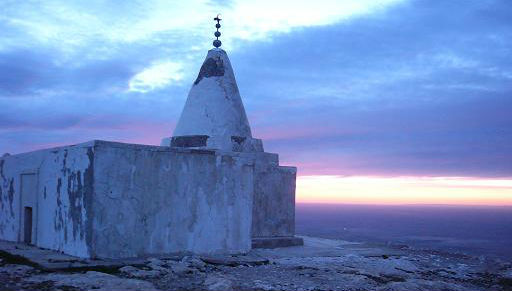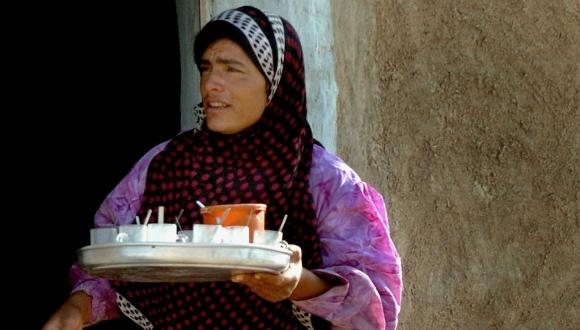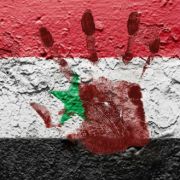Expert Analysis / The Yezidis: Traumatic Memory and Betrayal
Northern Iraq has witnessed a chain of dramatic political and military developments in recent months that have thrown the entire region into a vortex. It is estimated that since the Islamic State (IS; formerly ISIS)’s takeover of Mosul on June 10, northern Iraq has seen a population displacement similar in scope to that which took place during the years following the American invasion of Iraq in 2003. The majority of those recently displaced belong to the main religious and ethnic minorities of the region that have inhabited the Mosul region for centuries. These include the Yezidis, who are probably ethnic Kurds and believers of a distinct ancient religion that has its roots in Zoroastrianism, which has historically made them a target for religious persecution.
One controversial aspect of Yezidi belief is based on the story that Tawûsê Melek (“The Peacock Angel”), the chief Yezidi angel, is said to have disobeyed God’s (Allah’s) order to bow down to Adam. This story is similar to the Islamic story of Iblis, or Satan, who disobeyed Allah’s order and was cursed. The Yezidis are therefore considered by Islamists to be Satan worshippers, the worst kind of heresy. For this reason, they were targeted by the IS in a pre-planned and widely trumpeted massacre that shattered their communities.
On August 3, 2014, IS militants attacked and conquered the town of Sinjar, located at the southern foot of Mount Sinjar, a mountain range overlooking the plains of western Nineveh province, near the Iraqi-Syrian border. Sinjar is approximately fifty miles south of the southernmost point controlled by the Kurdistan Regional Government (KRG). Shortly after the IS incursion, Kurdish Peshmerga forces, assigned by the KRG during the last decade to protect the Yezidi enclave of Sinjar, abandoned their positions, paving the way for an IS takeover of the town and the entire region. Some 500 Yezidis were killed during the IS attack, and tens of thousands of others, living in towns and villages to the south and north of the Sinjar range were forced to flee to the mountains to avoid being massacred by IS.[1]
As a result, 80,000 people were besieged on the arid slopes and ravines of Jebel Sinjar (Mount Sinjar). Surrounding them on all sides were IS militants, who had declared that they were planning a fatal “rendezvous” with the “Satan worshipping” Yezidis after the Eid al-Fitr holiday on July 28 (which marked the end of Ramadan).[2] For weeks Yezidi refugees desperately sought shelter from the desert sun and safety from unpredictable nightly attacks by IS militants designed to kill Yezidi men and kidnap their women, some of whom were sold as sex-slaves in the markets in IS controlled cities in Iraq and Syria.[3] Prolonged exposure to the extreme temperatures on the mountain resulted in many deaths from thirst, hunger, and disease, mainly among children and the elderly.[4]

Pictured: A Yezidi temple in northern Iraq. Credit: Danpanic77/Wikimedia Commons
Three weeks after the outbreak of the Yezidi massacre in Sinjar, YPG (Yekîneyên Parastina Gel; “People's Protection Units”) fighters from Rojava (the Kurdish autonomous region in northern Syria) and PKK (Partiya Karkerên Kurdistan; “Kurdistan Workers' Party”) fighters from Turkey, managed to rescue the majority of Yezidi refugees from Mount Sinjar. Yet there are still approximately 4,000 people on the mountain, half of which decided to stay in order to fight with Yezidi militias against IS.[5] The Mount Sinjar refugees were joined by another wave of refugees, who were fleeing the Shaykhan region. Shaykhan is in the vicinity of the Yezidi religious center in the valley of Lalish, some thirty miles to the northeast of IS-controlled Mosul. Like other non-Sunni Arab religious and ethnic groups inhabiting the Nineveh Plain, the Shaykhan refugees fled their towns and villages a week after the onset of the Sinjar atrocities, fearing that IS forces would be moving eastward to occupy the region.
The Syrian Kurdish fighters transferred many of the refugees to cities and Yezidi villages in Iraqi Kurdistan through Rojava territory. Yezidi relief groups and NGOs estimated that the number of Yezidi Internally Displaced Persons (IDP) from Sinjar and Shaykhan taking refuge in Iraqi Kurdistan was somewhere between 300,000 and 400,000.[6] Recently, some of the Shaykhan refugees were able to return to their homes, as they realized that the IS threat had receded partly due to the increase in American airstrikes. While some of the Yezidi refugees that remained in Iraqi Kurdistan found shelter in Yezidi homes, the vast majority of them are still on the streets, in public gardens and construction sites in Kurdistan with no permanent solution in sight.
The events in Sinjar shattered the delicate social fabric of the Yezidi community and split many families. At this stage, a dominant Yezidi discourse has emerged that depicts the Sinjar events as the 74th Firman in a long chain of Firmanat, aiming to annihilate Yezidis and to eradicate their religion. In the original Ottoman Turkish, the term Firman means a Sultanic decree, while in Yezidi collective memory this term is a synonym for campaigns of persecution and annihilation brought upon the community by outside forces. This Yezidi discourse seeks to redefine Yezidi identity through a sense of shared trauma that has emerged in the shadow of fear of religious persecution.
This discourse reflects a separatist trend in the Yezidi community, which seeks to free Yezidis from outside efforts to determine their communal identity and self-perception. Saddam’s Baʿth regime, for example, referred to the Yezidis as “Umayyad-Arabs,” claiming they were descendants of the Umayyad caliph Yazid ibn Muʿawiya. In practice, however, the regime questioned the loyalty of Yezidis and targeted them for taking part in the Kurdish national movement. The Kurds, on the other hand, have embraced the Yezidi community and referred to them as the “authentic Kurds,” but in practice left them impoverished and marginalized in Kurdistan.
The new Yezidi discourse seeks to consolidate an alternative collective identity for a community all too familiar with oppression and disappointment, and to root it in the collective trauma of past persecutions. Thus, a new narrative emerged, which insisted that the Yezidis are a unique and distinctive people, different from the Kurds or any other nation, and ignored the existence of ethnic, linguistic, and cultural ties to other Iraqi ethnic groups.
This new identity discourse has gained significant traction among Yezidis since the American invasion of Iraq in 2003, in tandem with their growing fear, rooted in experience, that Muslim religious persecution is an existential threat for them in post-Saddam Iraq. These fears were realized when two villages near Sinjar were simultaneously attacked by the Iraqi al-Qaʿida branch in August 2007, resulting in the deaths of approximately 800 Yezidis and the complete destruction of the village centers.[7]
Since the August IS attack on Sinjar, the Yezidi separatist discourse has grown stronger. Yezidi activists affiliated with Kurdish political parties have gone absolutely silent following the IS attacks. Yezidi intellectuals and communal leaders have claimed that the Yezidi people have no friends and that even those pretending to be friends and defenders of the Yezidis are traitors, using the opportunity to harm Yezidis and benefit at their expense. Thus, while Yezidis blame IS for the atrocities perpetrated against them, they assign equal if not greater blame to the Iraqi Kurdistan leadership for abandoning them. For decades, leaders in Iraqi Kurdistan have promised to provide security and protection to Yezidis and treat them as if they were Kurdistan’s own flesh and blood. However, Yezidis feel that during the community’s decisive moment, KRG forces beat a hasty retreat and abandoned the Yezidis to a cruel fate.
1.jpg)
Pictured: The Yezidi flag. Credit: Wikimedia Commons
An article written by a Yezidi writer using the pseudonym ‘Abu Azad,’ claims that “the evidence confirms that Serbest Bapiri [the Peshmerga and Kurdish Democratic Party offıcıal ın Sinjar] was behind the Sinjar catastrophe […] and that had the Peshmerga not withdrawn from Sinjar, the disaster would not have happened in the first place. Witnesses among survivors accuse Bapiri of carrying out a secret deal with IS, in which he would abandon the Yezidis in exchange for a safe retreat of his men from Sinjar. However, Abu Azad was quick to qualify his remarks, saying, “Muslim Kurds had no part in the Sinjar catastrophe and one must not blame them for the sins of a commander or an official who betrayed.”[8] These reservations were probably added following the Kurdish claims that the Peshmerga withdrew from Sinjar for tactical reasons, to enable the provision of more advanced military equipment and to overcome the challenge of sending supplies inside the besieged enclave.
In an interview with the Kurdish-oriented Turkish newspaper Özgür Gündem, a Yezidi member of the Iraqi parliament, Viyan Dakhil, expanded the scope of the Yezidi narrative of betrayal and abandonment to include the Arab neighbors of Sinjar:
“Our neighbors betrayed us severely. They were the ones who brought ISIS to the region. They were supposedly our friends, acquaintances, and godfathers […] and we convinced ourselves that they would not do things like that, but when they attacked [us] it was devastating for us. [...] They demolished our homes in Sinjar and their men looted our possessions. They kidnapped women and killed men. All these are enormous tragedies, but ISIS is not our only problem – our Arab neighbors betrayed us severely.” [9]
In sum, the ascent of IS, and the resultant calamity of Sinjar, has brought the Yezidi separatist discourse to center stage, as Yezidis seek to resolve their predicament. For most Yezidis, returning to their homes and lands in Shaykhan and Sinjar is no longer possible. Moreover, they believe that it will be virtually impossible to alleviate their plight within the framework of the Kurdish national movement and the KRG, which often expresses hostility and intolerance towards Yezidis. Hence, the Yezidi predicament should be resolved according to most Yezidis in alternative ways that do not include Iraqi Kurdistan.
In this context, Yezidi intellectuals and leaders, in Iraq and the diaspora, have been raising various alternative solutions for the Yezidis, some of which are extremely creative. At the forefront of these solutions is an old idea among minorities of the region: the establishment of a statelet for religious minorities in the Nineveh plain, protected by the international community and providing them full freedom from religious persecution or political pressure.
Another possible solution recently raised by Yezidi leaders is the resettlement of the entire Yezidi community in Armenia, currently home to a Yezidi community of about 40,000 people that enjoys relative protection from persecution and fair treatment by the Armenian authorities. Interestingly, Israel is also often mentioned as a possible long-term solution for the Yezidi community. Whatever solution is adopted, in order for it to be meaningful it will have to encompass the entire Yezidi community to ensure the preservation of its religious uniqueness and communal identity, and to provide protection to its members from the threat of annihilation.
Idan Barir is a Ph.D. candidate at the Yavetz School of Historical Studies, Tel Aviv University. The title of his master's thesis is, "This is Our Story: The Yezidi Cultural Movement and the Processes of a Collective Identity Construction among the Yezidis in Kurdistan and the Diaspora."
[1] Mohammed A. Salih and Wladimir van Wilgenburg, "Iraqi Yazidis: 'If We Move They Will Kill Us'," Aljazeera, August 5, 2014.
[2] Ali Sedo Rasho, “ʿAn Buʾs al-Ayzidiyya bayna Daʿish wal-Bayshmarka” [On the Yezidi Disaster: between ISIS and the Peshmerga], Al-Ḥiwar al-Mutamaddin, September 1, 2014.
[3] Ford Sypher, "Rape and Sexual Slavery Inside an ISIS Prison," The Daily Beast, August 28, 2014.
[4] Jonathan Krohn, “Iraq Crisis: 'It Is Death Valley. Up to 70 Per Cent of Them Are Dead'," The Telegraph, August 10, 2014.
[5] Spencer Ackerman, Mona Mahmood, Ian Saleh and Kenton Powell, “Yazidis Still Stranded on Mount Sinjar: 'We Need Weapons Now more Than Food or Water',” The Guardian, August 27, 2014.
[6] Detailed statistics on the current dispersal of Yezidi refugees in Iraqi Kurdistan were sent to me on August 22 by Khidher Domle, a Yezidi journalist and aid activist, who is currently coordinating aid efforts in the Yezidi village of Sharia.
[7] Idan Barir, “The Yezidis of Iraq: An Endangered Minority,” Tel Aviv Notes, August 30, 2007.
[8] Abu Azad (pseudonym), “Limadha Karithat Sinjar?” [Why the Catastrophe of Sinjar?], Bahzani.net, August 14, 2014.
[9] Ersin Çaksu and Önder Elaldi, "Kirvelerimiz Ihanet Etti!” [Our Godfathers Betrayed Us!], Özgür Gündem, August 18, 2014.
 TEL AVIV NOTES is an analytical update on current affairs in the Middle East, published by Tel Aviv University’s Moshe Dayan Center for Middle Eastern and African Studies, with the support of the V. Sorell Foundation.
TEL AVIV NOTES is an analytical update on current affairs in the Middle East, published by Tel Aviv University’s Moshe Dayan Center for Middle Eastern and African Studies, with the support of the V. Sorell Foundation.






